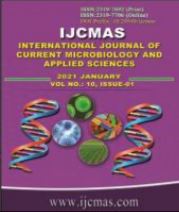


 National Academy of Agricultural Sciences (NAAS)
National Academy of Agricultural Sciences (NAAS)

|
PRINT ISSN : 2319-7692
Online ISSN : 2319-7706 Issues : 12 per year Publisher : Excellent Publishers Email : editorijcmas@gmail.com / submit@ijcmas.com Editor-in-chief: Dr.M.Prakash Index Copernicus ICV 2018: 95.39 NAAS RATING 2020: 5.38 |
Four local efficient biofertilizer strains namely, Gluconacetobacter G1 and Azospirillum ACD-15 as nitrogen fixers, Pseudomonas striata as phosphorus solubilizing bacterium and a potassium solubilizing bacterium were used in developing NPK biofertilizer consortia. Each NPK consortia consisted of one of the two nitrogen fixing bacteria, the phosphate solubilizing (PSB) and potassium solubilizing (KSB) bacteria in five different formulations namely, lignite, kaolinite, liquid, Na-alginate and bentonite. These formulations were evaluated under in vitro on maize germination and seedling vigour. Growth kinetics of each strain was used in developing consortia after their compatibility was confirmed. The population of each of the four strains in the formulations were assessed at ambient conditions over 90 days. The survival of individual strain in the formulations of consortia and their influence on maize seedling vigour were used to identify efficiency of formulations of NPK consortia. Among the five formulations, liquid and Na-alginate formulations supported significantly higher population of biofertilizer strains after 90 DAS. Liquid formulation recorded the highest maize germination (94.25 per cent) and Na-alginate formulation recorded the highest maize seedling vigour (3850.43).
 |
 |
 |
 |
 |